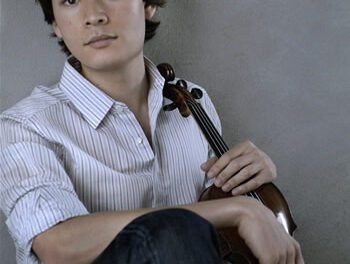Music Director Dmitry Sitkovetsky conducted the Greensboro Symphony Orchestra in the next-to-last Masterpiece concert Saturday night. From the lively tempos of some of the works featured, one tended to take seriously what GSO CEO Lisa Crawford explained in opening comments — no intermission, and “we’ll have you out of here by about 9:15.” It was a concert designed for those interested in catching the NCAA game action on TV that night!
The Overture to Mozart’s opera The Marriage of Figaro started the evening off in a bubbly fashion — dangerously fast, but fun throughout. And what’s not to like? The entire orchestra was tight, with winds and brass tossing off licks like water off a duck’s back.
Soprano Christina Pier, the most recent winner of the Charles A. Lynam Vocal Competition at UNCG, joined the orchestra for the singing of two selections from Figaro. In the aria “Porgi, amor,” the Countess laments her husband’s infidelity; it is slow and a sad moment in the opera. Pier was simply superb. She effortlessly spun out long lines with gorgeous vocal timbre that caught the emotion of a wounded woman wonderfully.
The aria “Dove sono” was preceded by the accompanying recitative and allowed for a more vigorous and angry response to the Countess’ situation. Here Pier breathed fire. What a delight to hear such magnificent singing — intonation was right on, diction perfect, and Sitkovetsky made sure the orchestra was with the dynamic singer every step of the way. I would have preferred an ensemble about half the size of what was there, and a harpsichord would have added authenticity to the proceedings. And there were many in the enthused audience who would have liked to hear a lot more of Pier’s singing.
Three movements from Mendelssohn’s A Midsummer Night’s Dream followed. The Overture was written in 1829, when the composer was only seventeen years old. It immediately established the young musician as a force to be reckoned with. The orchestration is brilliant, and the movement very clearly characterizes the worlds that are brought together in the play: fairies and humans.
The Nocturne is lyrical and beautiful, with a great melody for the horn, solidly played by Robert Campbell. The Scherzo is pure magic, and Sitkovetsky took the movement full-throttle. Full of elfin characters, the music fairly flew, and the orchestra was able to hold everything together, offering not only scurrying sixteenth notes, but also great color to boot.
The rest of the evening was given over to Beethoven’s Second Symphony, in D. Conventional wisdom has it that the odd-numbered symphonies (with the addition of No. 6, the “Pastorale”) are the best. However, upon hearing this less-performed work, I would take issue with the adage.
The first movement begins with a long, slow introduction that features some great wind writing. Many would say that the work is Mozartian, and while that is true, there is plenty that is pure Beethoven — unusual changes of key and characters, for example. An Allegro follows, with plenty of good spirits.
The Larghetto slow movement is all about elegance, which the GSO delivered in fine style. The third movement, Scherzo, seemed a bit tame in terms of tempo, and although it was solidly played, it lacked some of the vitality that had characterized the rest of the evening.
The last movement, however, made up for any slacking of energy — perhaps Sitkovetsky intentionally took the Scherzo at a deliberate tempo so that it would serve as a foil to the Finale. In any case, the Finale’s quirky nature, with sudden mood shifts, was brought off in great spirits.
The crowd was energized by the evening’s music, and Crawford was true to her word: we did get out of the hall by 9:20.












